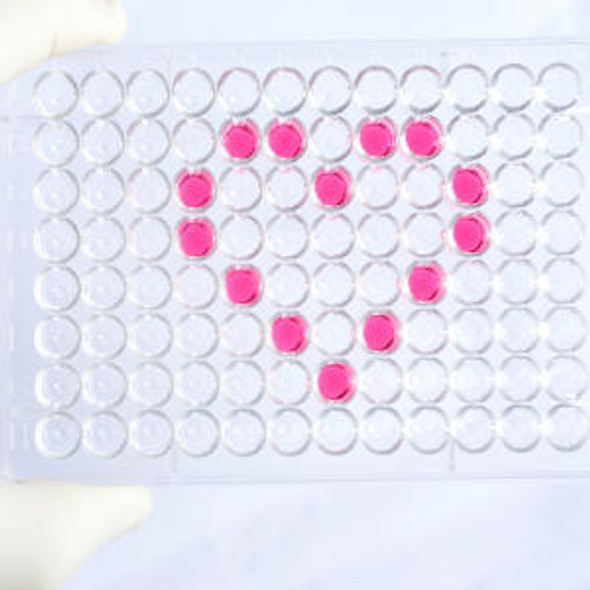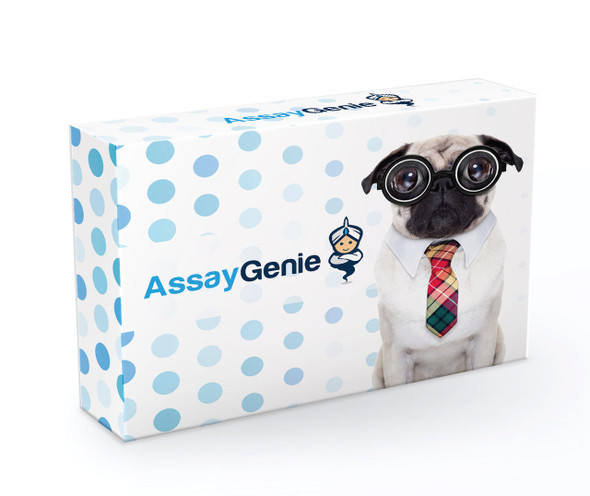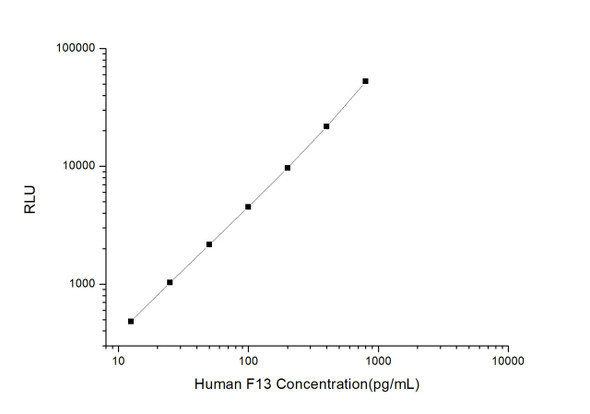Human Immunology ELISA Kits 1
Human F8 (Coagulation Factor 8) CLIA Kit (HUES00522)
- SKU:
- HUES00522
- Product Type:
- ELISA Kit
- ELISA Type:
- CLIA Kit
- Size:
- 96 Assays
- Sensitivity:
- 37.5pg/mL
- Range:
- 62.5-4000pg/mL
- ELISA Type:
- Sandwich
- Reactivity:
- Human
- Sample Type:
- Serum, plasma and other biological fluids
- Research Area:
- Immunology
Description
| Assay type: | Sandwich |
| Format: | 96T |
| Assay time: | 4.5h |
| Reactivity: | Human |
| Detection method: | Chemiluminescence |
| Detection range: | 62.50-4000 pg/mL |
| Sensitivity: | 37.50 pg/mL |
| Sample volume: | 100µL |
| Sample type: | Serum, plasma and other biological fluids |
| Repeatability: | CV < 15% |
| Specificity: | This kit recognizes Human F8 in samples. No significant cross-reactivity or interference between Human F8 and analogues was observed. |
This kit uses Sandwich-CLIA as the method. The micro CLIA plate provided in this kit has been pre-coated with an antibody specific to Human F8. Standards or samples are added to the appropriate micro CLIA plate wells and combined with the specific antibody. Then a biotinylated detection antibody specific for Human F8 and Avidin-Horseradish Peroxidase (HRP) conjugate are added to each micro plate well successively and incubated. Free components are washed away. The substrate solution is added to each well. Only those wells that contain Human F8, biotinylated detection antibody and Avidin-HRP conjugate will appear fluorescence. The Relative light unit (RLU) value is measured spectrophotometrically by the Chemiluminescence immunoassay analyzer. The RLU value is positively associated with the concentration of Human F8. The concentration of Human F8 in the samples can be calculated by comparing the RLU of the samples to the standard curve.
| UniProt Protein Function: | F8: Factor VIII, along with calcium and phospholipid, acts as a cofactor for factor IXa when it converts factor X to the activated form, factor Xa. Defects in F8 are the cause of hemophilia A (HEMA). A disorder of blood coagulation characterized by a permanent tendency to hemorrhage. About 50% of patients have severe hemophilia resulting in frequent spontaneous bleeding into joints, muscles and internal organs. Less severe forms are characterized by bleeding after trauma or surgery. Of particular interest for the understanding of the function of F8 is the category of CRM (cross-reacting material) positive patients (approximately 5%) that have considerable amount of F8 in their plasma (at least 30% of normal), but the protein is non- functional; i. e. the F8 activity is much less than the plasma protein level. CRM-reduced is another category of patients in which the F8C antigen and activity are reduced to approximately the same level. Most mutations are CRM negative, and probably affect the folding and stability of the protein. Belongs to the multicopper oxidase family. 2 isoforms of the human protein are produced by alternative splicing. |
| UniProt Protein Details: | Protein type:Secreted, signal peptide; Secreted Chromosomal Location of Human Ortholog: Xq28 Cellular Component: extracellular space; extracellular region; plasma membrane Molecular Function:protein binding; copper ion binding; serine-type endopeptidase activity; oxidoreductase activity Biological Process: platelet activation; platelet degranulation; acute-phase response; proteolysis; blood coagulation; blood coagulation, intrinsic pathway Disease: Hemophilia A; Factor Viii Deficiency |
| NCBI Summary: | This gene encodes coagulation factor VIII, which participates in the intrinsic pathway of blood coagulation; factor VIII is a cofactor for factor IXa which, in the presence of Ca+2 and phospholipids, converts factor X to the activated form Xa. This gene produces two alternatively spliced transcripts. Transcript variant 1 encodes a large glycoprotein, isoform a, which circulates in plasma and associates with von Willebrand factor in a noncovalent complex. This protein undergoes multiple cleavage events. Transcript variant 2 encodes a putative small protein, isoform b, which consists primarily of the phospholipid binding domain of factor VIIIc. This binding domain is essential for coagulant activity. Defects in this gene results in hemophilia A, a common recessive X-linked coagulation disorder. [provided by RefSeq, Jul 2008] |
| UniProt Code: | P00451 |
| NCBI GenInfo Identifier: | 119767 |
| NCBI Gene ID: | 2157 |
| NCBI Accession: | P00451. 1 |
| UniProt Secondary Accession: | P00451,Q14286, Q5HY69, |
| UniProt Related Accession: | P00451 |
| Molecular Weight: | 24,641 Da |
| NCBI Full Name: | Coagulation factor VIII |
| NCBI Synonym Full Names: | coagulation factor VIII, procoagulant component |
| NCBI Official Symbol: | F8 |
| NCBI Official Synonym Symbols: | AHF; F8B; F8C; HEMA; FVIII; DXS1253E |
| NCBI Protein Information: | coagulation factor VIII; factor VIII F8B; antihemophilic factor; coagulation factor VIIIc |
| UniProt Protein Name: | Coagulation factor VIII |
| UniProt Synonym Protein Names: | Antihemophilic factor; AHF; Procoagulant componentCleaved into the following 4 chains:Factor VIIIa heavy chain, 200 kDa isoform; Factor VIIIa heavy chain, 92 kDa isoform; Factor VIII B chain; Factor VIIIa light chain |
| Protein Family: | Factor VIII intron 22 protein |
| UniProt Gene Name: | F8 |
| UniProt Entry Name: | FA8_HUMAN |
As the RLU values of the standard curve may vary according to the conditions of the actual assay performance (e. g. operator, pipetting technique, washing technique or temperature effects), the operator should establish a standard curve for each test. Typical standard curve and data is provided below for reference only.
| Concentration (pg/mL) | RLU | Average | Corrected |
| 4000 | 56088 62074 | 59081 | 59046 |
| 2000 | 26282 29436 | 27859 | 27824 |
| 1000 | 14631 12337 | 13484 | 13449 |
| 500 | 6467 6743 | 6605 | 6570 |
| 250 | 3431 3055 | 3243 | 3208 |
| 125 | 1690 1472 | 1581 | 1546 |
| 62.50 | 725 785 | 755 | 720 |
| 0 | 35 35 | 35 | -- |
Precision
Intra-assay Precision (Precision within an assay): 3 samples with low, mid range and high level Human F8 were tested 20 times on one plate, respectively.
Inter-assay Precision (Precision between assays): 3 samples with low, mid range and high level Human F8 were tested on 3 different plates, 20 replicates in each plate.
| Intra-assay Precision | Inter-assay Precision | |||||
| Sample | 1 | 2 | 3 | 1 | 2 | 3 |
| n | 20 | 20 | 20 | 20 | 20 | 20 |
| Mean (pg/mL) | 211.11 | 377.50 | 1679.54 | 230.89 | 360.33 | 1787.94 |
| Standard deviation | 23.39 | 31.94 | 144.10 | 19.26 | 32.25 | 132.49 |
| C V (%) | 11.08 | 8.46 | 8.58 | 8.34 | 8.95 | 7.41 |
Recovery
The recovery of Human F8 spiked at three different levels in samples throughout the range of the assay was evaluated in various matrices.
| Sample Type | Range (%) | Average Recovery (%) |
| Serum (n=5) | 93-107 | 99 |
| EDTA plasma (n=5) | 88-102 | 94 |
| Cell culture media (n=5) | 89-102 | 95 |
Linearity
Samples were spiked with high concentrations of Human F8 and diluted with Reference Standard & Sample Diluent to produce samples with values within the range of the assay.
| Serum (n=5) | EDTA plasma (n=5) | Cell culture media (n=5) | ||
| 1:2 | Range (%) | 88-100 | 93-106 | 86-100 |
| Average (%) | 93 | 100 | 93 | |
| 1:4 | Range (%) | 95-108 | 88-102 | 84-99 |
| Average (%) | 101 | 94 | 91 | |
| 1:8 | Range (%) | 94-107 | 98-112 | 86-97 |
| Average (%) | 100 | 103 | 91 | |
| 1:16 | Range (%) | 91-108 | 102-120 | 92-107 |
| Average (%) | 99 | 109 | 97 |
An unopened kit can be stored at 4°C for 1 month. If the kit is not used within 1 month, store the items separately according to the following conditions once the kit is received.
| Item | Specifications | Storage |
| Micro CLIA Plate(Dismountable) | 8 wells ×12 strips | -20°C, 6 months |
| Reference Standard | 2 vials | |
| Concentrated Biotinylated Detection Ab (100×) | 1 vial, 120 µL | |
| Concentrated HRP Conjugate (100×) | 1 vial, 120 µL | -20°C(shading light), 6 months |
| Reference Standard & Sample Diluent | 1 vial, 20 mL | 4°C, 6 months |
| Biotinylated Detection Ab Diluent | 1 vial, 14 mL | |
| HRP Conjugate Diluent | 1 vial, 14 mL | |
| Concentrated Wash Buffer (25×) | 1 vial, 30 mL | |
| Substrate Reagent A | 1 vial, 5 mL | 4°C (shading light) |
| Substrate Reagent B | 1 vial, 5 mL | 4°C (shading light) |
| Plate Sealer | 5 pieces | |
| Product Description | 1 copy | |
| Certificate of Analysis | 1 copy |
- Set standard, test sample and control (zero) wells on the pre-coated plate and record theirpositions. It is recommended to measure each standard and sample in duplicate. Note: addall solutions to the bottom of the plate wells while avoiding contact with the well walls. Ensuresolutions do not foam when adding to the wells.
- Aliquot 100µl of standard solutions into the standard wells.
- Add 100µl of Sample / Standard dilution buffer into the control (zero) well.
- Add 100µl of properly diluted sample (serum, plasma, tissue homogenates and otherbiological fluids. ) into test sample wells.
- Cover the plate with the sealer provided in the kit and incubate for 90 min at 37°C.
- Aspirate the liquid from each well, do not wash. Immediately add 100µL of BiotinylatedDetection Ab working solution to each well. Cover the plate with a plate seal and gently mix. Incubate for 1 hour at 37°C.
- Aspirate or decant the solution from the plate and add 350µL of wash buffer to each welland incubate for 1-2 minutes at room temperature. Aspirate the solution from each well andclap the plate on absorbent filter paper to dry. Repeat this process 3 times. Note: a microplatewasher can be used in this step and other wash steps.
- Add 100µL of HRP Conjugate working solution to each well. Cover with a plate seal andincubate for 30 min at 37°C.
- Aspirate or decant the solution from each well. Repeat the wash process for five times asconducted in step 7.
- Add 100µL of Substrate mixture solution to each well. Cover with a new plate seal andincubate for no more than 5 min at 37°C. Protect the plate from light.
- Determine the RLU value of each well immediately.






